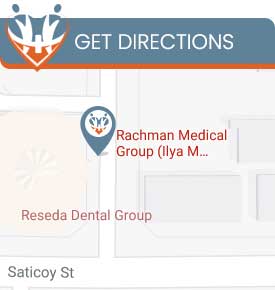Osteoarthritis Management Clinic in Reseda, CA
Managing osteoarthritis is a comprehensive process that focuses on symptom relief and enhancing an individual’s overall well-being since there is no known cure for this condition. Osteoarthritis initiates a gradual breakdown of the cartilage within a joint, accompanied by alterations in the underlying bone structure. Osteoarthritis treatment is available at Rachman Medical Group. For more information, contact us today or request an appointment online. We are conveniently located at 7601 Canby Ave Suite 7 Reseda, CA 91335.


Table of Contents:
What is osteoarthritis?
What causes osteoarthritis?
How do I know if I have osteoarthritis?
What is the management for osteoarthritis?
Osteoarthritis is a chronic, degenerative condition that primarily impacts individuals in their middle-aged and later years. It gradually manifests as changes within the joint tissues, typically unfolding over an extended period, although occasional variations exist. This ailment leads to the deterioration of joint cartilage, potentially affecting any joint but more commonly impacting the hands, knees, hips, or spine.
Osteoarthritis is a condition that affects the entirety of a joint, encompassing bone, ligaments, cartilage, and the synovial membrane that lines the joint. This ailment has the potential to erode cartilage, alter the shape of bones, and induce inflammation, leading to the manifestation of symptoms like pain, stiffness, and a decrease in joint mobility.
Osteoarthritis can be divided into two main types including primary and secondary. Primary osteoarthritis, which lacks a clearly defined cause, typically arises spontaneously. On the other hand, secondary osteoarthritis is brought about by various factors such as underlying diseases, infections, injuries, or structural deformities in the joint.
Secondary osteoarthritis often occurs in conjunction with pre-existing joint abnormalities, including injuries or traumas, inflammatory arthritis, genetic joint disorders, congenital joint disorders, and more.
Osteoarthritis begins with the breakdown of the cartilage within the joint. As cartilage deteriorates, the ends of the bones may thicken and form bone spurs, which can interfere with joint movement. Additionally, small fragments of bone and cartilage may float within the joint space, and fluid-filled cysts might develop within the bone, limiting joint movement. Ultimately, when the cartilage completely wears away, the bones will rub against each other.
Several factors influence the likelihood of developing osteoarthritis. The risk of osteoarthritis increases with age, and symptoms generally, though not always, manifest in individuals over the age of 50. Osteoarthritis can also be triggered by factors such as bone fractures or tears in cartilage or ligaments, sometimes leading to a more rapid onset than cases without obvious injuries.
Repetitive use of the same joints in occupational or sporting activities can contribute to the development of osteoarthritis. Carrying excess body weight also plays a role in osteoarthritis development, as it adds stress to weight-bearing joints, particularly the hips and knees. Additionally, some individuals inherit a genetic predisposition that makes them more prone to developing osteoarthritis.
Determining whether you have osteoarthritis involves recognizing certain characteristic signs and symptoms. Osteoarthritis initiates a gradual breakdown of the cartilage within a joint, accompanied by alterations in the underlying bone structure.
These changes typically progress slowly and deteriorate over time, resulting in pain, stiffness, and swelling in the affected joint. Additionally, osteoarthritis may lead to diminished joint function and disability. Pain associated with osteoarthritis is often exacerbated when you move the joint or towards the end of the day. After periods of rest, your joints may feel stiff, but this stiffness generally subsides fairly quickly once you start moving.
To identify osteoarthritis, the primary diagnostic tool is X-ray imaging of the affected joints. Common X-ray findings in osteoarthritis include the loss of joint cartilage, a narrowing of the space between adjacent bones within the joint, and the formation of bone spurs.
Simple X-ray tests are highly valuable for ruling out other potential causes of joint pain and aiding in decisions regarding the potential need for surgical intervention. If you suspect you have osteoarthritis, it’s advisable to seek evaluation and diagnosis from family and internal medicine practices like Rachman Medical Group.
Managing osteoarthritis is a comprehensive process that focuses on symptom relief and enhancing an individual’s overall well-being since there is no known cure for this condition. This approach is highly personalized, taking into account the unique needs and circumstances of each patient. At Rachman Medical Group, healthcare professionals work closely with patients to develop a tailored plan.
One key aspect of managing osteoarthritis involves promoting an active lifestyle. Encouraging physical activity helps improve joint function and mobility, and it can be tailored to an individual’s capabilities and preferences.
Additionally, weight management is emphasized to reduce stress on weight-bearing joints, which can significantly alleviate symptoms. Physical therapy plays a pivotal role in osteoarthritis management, with a focus on muscle-strengthening exercises that help enhance joint stability and function. Medications, such as pain relievers and anti-inflammatory drugs, are also utilized as necessary to manage pain and inflammation.
In certain situations, minimally invasive interventions like corticosteroid injections may be considered and sometimes surgical interventions may be necessary.
Osteoarthritis treatment is available at Rachman Medical Group. We serve patients from Reseda CA, San Fernando CA, Twin Lakes CA, Hidden Hills CA, and Burbank CA.

Additional Services You May Like
▸ Primary Care
▸ Medicare
▸ Diabetes
▸ Hypertension
▸ Medicare Advantage Primary Care
▸ Internal Medicine
▸ Management of Chronic Conditions
▸ Primary Care for Medicare Patients
▸ Type 1 Diabetes
▸ Type 2 Diabetes

Additional Services You May Like
▸ Primary Care
▸ Medicare
▸ Diabetes
▸ Hypertension
▸ Medicare Advantage Primary Care
▸ Internal Medicine
▸ Management of Chronic Conditions
▸ Primary Care for Medicare Patients
▸ Type 1 Diabetes
▸ Type 2 Diabetes





